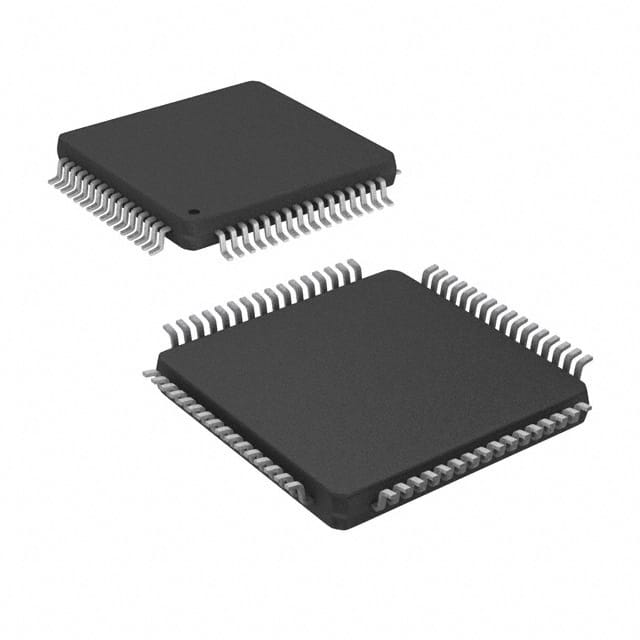Viz Specifikace pro podrobnosti o produktu.

ADS1198CPAGR
Product Overview
Category
The ADS1198CPAGR belongs to the category of integrated circuits (ICs) specifically designed for biomedical applications.
Use
This IC is primarily used in medical devices for acquiring and processing bioelectric signals, such as electrocardiograms (ECGs) and electromyograms (EMGs).
Characteristics
- High-resolution: The ADS1198CPAGR offers high-resolution analog-to-digital conversion, enabling accurate signal acquisition.
- Low power consumption: This IC is designed to operate with low power consumption, making it suitable for portable medical devices.
- Noise filtering: It incorporates built-in filters to reduce noise interference and enhance signal quality.
- Flexible input configuration: The ADS1198CPAGR supports multiple electrode configurations, allowing for versatile signal acquisition.
Package
The ADS1198CPAGR comes in a small form factor package known as TQFP (Thin Quad Flat Pack), which facilitates easy integration into electronic systems.
Essence
The essence of the ADS1198CPAGR lies in its ability to acquire and process bioelectric signals accurately and efficiently, making it an essential component in medical devices.
Packaging/Quantity
This IC is typically packaged in reels or tubes, containing a specific quantity per package. The exact packaging and quantity may vary depending on the supplier.
Specifications
- Resolution: 24 bits
- Sampling Rate: Up to 32 kSPS (samples per second)
- Input Channels: 8 differential or 16 single-ended channels
- Supply Voltage Range: 2.7V to 5.25V
- Operating Temperature Range: -40°C to +85°C
Detailed Pin Configuration
The ADS1198CPAGR has a total of 48 pins, each serving a specific function. Here is a detailed pin configuration:
- VREFP: Positive reference voltage input
- VREFN: Negative reference voltage input
- AVDD: Analog power supply
- DVDD: Digital power supply
- RESET: Reset pin for device initialization
- CLK: Clock input for synchronization
- CS: Chip select input
- DRDY: Data ready output
- START: Start conversion input
- PWDN: Power-down control input
- TEST: Test mode selection input 12-19. AINP0-AINP7: Positive analog input channels 20-27. AINN0-AINN7: Negative analog input channels 28-35. GPIO0-GPIO7: General-purpose input/output pins 36-43. DGND: Digital ground 44-48. AGND: Analog ground
Functional Features
- High-resolution ADC: The ADS1198CPAGR provides 24-bit resolution, ensuring accurate signal acquisition and processing.
- Flexible input configuration: It supports both differential and single-ended input configurations, allowing for versatile electrode arrangements.
- Built-in filters: This IC incorporates programmable filters to reduce noise interference and enhance signal quality.
- Low power consumption: Designed for portable medical devices, the ADS1198CPAGR operates with low power consumption, prolonging battery life.
Advantages and Disadvantages
Advantages
- High-resolution ADC ensures precise signal acquisition.
- Versatile input configuration accommodates various electrode arrangements.
- Built-in filters improve signal quality by reducing noise interference.
- Low power consumption extends battery life in portable medical devices.
Disadvantages
- Limited number of input channels (8 differential or 16 single-ended).
- Higher cost compared to lower-resolution alternatives.
- Requires external components for complete system integration.
Working Principles
The ADS1198CPAGR works based on the principle of analog-to-digital conversion. It receives bioelectric signals from the input channels, amplifies and filters them to enhance signal quality, and then converts them into digital data using its high-resolution ADC. The digital data can be further processed or transmitted for analysis.
Detailed Application Field Plans
The ADS1198CPAGR finds extensive application in various medical devices, including: - Electrocardiography (ECG) monitors - Electromyography (EMG) devices - Portable health monitoring systems - Sleep apnea detection devices - Stress testing equipment
Detailed and Complete Alternative Models
- ADS1298: Similar to the ADS1198CPAGR, this IC offers 24-bit resolution and supports up to 8 differential or 16 single-ended channels.
- ADS1294: This IC provides a lower-cost alternative with 24-bit resolution and support for up to 4 differential or 8 single-ended channels.
- ADS1256: A lower-resolution option with 24-bit ADC and support for up to 8 differential or 15 single-ended channels.
These alternative models offer varying features and specifications, allowing designers to choose the most suitable option based on their specific requirements
Seznam 10 běžných otázek a odpovědí souvisejících s aplikací ADS1198CPAGR v technických řešeních
Sure! Here are 10 common questions and answers related to the application of ADS1198CPAGR in technical solutions:
Q: What is ADS1198CPAGR? A: ADS1198CPAGR is a high-performance, low-power, 8-channel analog front-end (AFE) for biopotential measurements, commonly used in medical and healthcare applications.
Q: What are the key features of ADS1198CPAGR? A: Some key features include low noise, high input impedance, programmable gain, integrated lead-off detection, and simultaneous sampling of all channels.
Q: What is the typical power consumption of ADS1198CPAGR? A: The typical power consumption of ADS1198CPAGR is around 400µA, making it suitable for battery-powered applications.
Q: Can ADS1198CPAGR be used for ECG (Electrocardiogram) measurements? A: Yes, ADS1198CPAGR is commonly used for ECG measurements due to its high accuracy and low noise characteristics.
Q: How many leads can be connected to ADS1198CPAGR? A: ADS1198CPAGR supports up to 8 leads, allowing for multi-channel biopotential measurements.
Q: Does ADS1198CPAGR have built-in protection against electrode lead-off conditions? A: Yes, ADS1198CPAGR has integrated lead-off detection circuitry to detect and indicate when an electrode becomes disconnected or loose.
Q: Can ADS1198CPAGR interface with microcontrollers or digital signal processors (DSPs)? A: Yes, ADS1198CPAGR communicates using a serial peripheral interface (SPI), making it compatible with various microcontrollers and DSPs.
Q: What is the resolution of ADS1198CPAGR? A: ADS1198CPAGR has a resolution of 24 bits, allowing for precise measurement of biopotential signals.
Q: Can ADS1198CPAGR be used in wearable devices? A: Yes, ADS1198CPAGR's low power consumption and small form factor make it suitable for integration into wearable health monitoring devices.
Q: Are evaluation boards or reference designs available for ADS1198CPAGR? A: Yes, Texas Instruments provides evaluation boards and reference designs to help developers quickly prototype and integrate ADS1198CPAGR into their applications.
Please note that these answers are general and may vary depending on the specific implementation and requirements of your technical solution.

